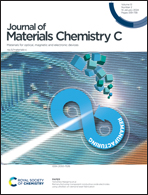Water stimulus-responsive room temperature afterglow materials with color tunability based on inorganic/organic H–G hybrid systems†
Abstract
Achieving stimuli-responsive room temperature afterglow (RTA) materials with color-tunability is attractive and meaningful but rarely reported. Herein, we propose an effective strategy to construct excitation-wavelength dependent inorganic/organic hybrid systems with color-tunability by introducing a benzoic acid derivative into an inorganic HBA matrix (IPA@HBA, TPA@HBA and PA@HBA). IPA@HBA systems with different proportions of IPA exhibit diverse color tunable RTA performance with wavelength-dependence, while TPA@HBA and PA@HBA display only excitation-wavelength-dependent RTA feature with intensity change. Notably, IPA@HBA systems possess an unusual water-stimulus response characteristic with a transition to green RTA owing to the formation of robust bridge-like hydrogen-bonded networks between IPA and HBA by non-freezing bound water, which has been rarely reported so far. Differently, TPA@HBA and PA@HBA display only weak or no green RTA owing to the weaker hydrogen-bonded networks between TPA or PA and HBA. Importantly, they can achieve repeatability after alternating stimulation by heat and water for many times. Thereby, an advanced information encryption application was successfully developed using multiple hybrid materials. These unique features endow multifunctional stimuli-responsive RTA materials with color tuning ability for remarkable information encryption applications.



 Please wait while we load your content...
Please wait while we load your content...